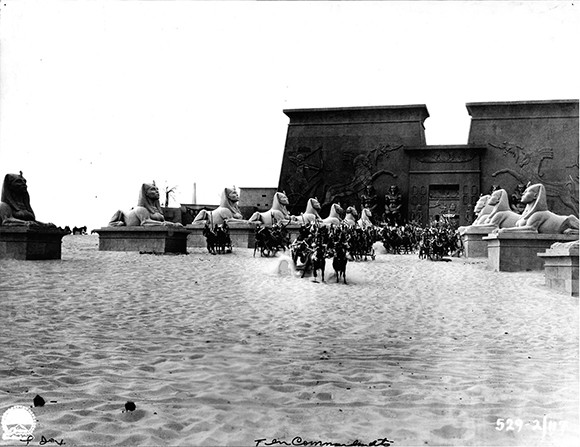
Remnants of director Cecil DeMille’s production of “The Ten Commandments” still sit beneath the Guadalupe-Nipomo dunes. (Courtesy image)
Remnants of Cecil DeMille’s 1923 film “The Ten Commandments” were hidden away for years in the shifting sands of the Guadalupe-Nipomo dunes. But recently some of the massive plaster sphinxes used during the monumental production have revealed themselves thanks to fortunate winds.
With the potential to draw more visitors, the Dunes Center, which hosts exhibits, educational programs and tours, is raising money to revamp its exhibits. The project includes new landscaping to bring the flora and fauna found in the dunes to a central location.
And, as if on cue, a new version of the Moses story is set to hit the big screen on Dec. 12 as Chrisian Bale stars in Ridley Scott’s new film, “Exodus.”
But Doug Jenzen, the center’s executive director, said his vision extends beyond its DeMille legacy.
“ ‘The Ten Commandments’ movie is one of two dozen films that shot in and around Guadalupe,” he said. “The exhibit is going to focus on ‘The Ten Commandments,’ but will also have information on the others that have been produced here.”
The exhibit’s centerpiece is the body of one of 21 sphinx monoliths used in DeMille’s production. The pieces are currently being restored off-site. The entire dig will cost roughly $120,000, according to Jenzen.
The head of a partially exhumed sphinx was recovered in 2012 and put on display, but money ran out before archeologists could recover the full body. When the crew returned, weather had collapsed the delicate structure. That excavation cost about $200,000.
The 21 giant sphinxes lined a path to an 800-foot-wide temple. According to the movie’s lore, when filming wrapped the set was too expensive to move and instead of leaving it for future productions, DeMille had it buried. Jenzen said the sphinxes were not moved after the cameras stopped rolling.
“The story itself is fascinating,” he said. “During filming … there were roughly 5,000 actors and construction workers who lived in a camp in the dunes. Over the years we’ve collected a lot of cultural material, tobacco tins and prohibition alcohol bottles.”
The uncovering of the sphinxes has been a shot in the arm for the Dunes Center. While the center has had artifacts from the movie since the 1990s, film archaeology was not a focus until two years ago, when a donor produced the funds for the original dig.
With the overhauled exhibit in the works, Jenzen said the Dunes Center is acquiring funding for the new public open space that wraps around the current building. The project will feature plants from the coastline and provide those unable to access the beach, due to age or ability, the opportunity to discover its foliage.
“It should be a great contribution to northern Santa Barbara County,” Jenzen said. “We’ve already hosted 16,000 people this year, and with more professional exhibits we’re hoping to build on that. When the story of movie set went viral in October, we we’re kind of caught off-guard.”
Given that the Dunes Center is a nonprofit, the new wave of attention should help in attracting new donors. The funding needed to complete both projects amounts to about $237,000, and Jenzen said he hopes to hit that number by the end of next year.
The Dunes Center’s operating budget this year is $400,000. Last year it was $384,000, and in 2011 in was just $150,000. Jenzen credits a healthier economy and the new interest related to the movie productions for the increases.
“There’s a lot that the Dunes Center does, but we’re a little removed by location from the tourism community,” he said. “Our education programming in San Luis Obispo and Santa Barbara counties is really important in exposing the outdoors to students. Last year we hosted 10,000-plus children from various elementary schools, and the only way we are to do projects like that is through generosity of the residents and donors here.”






 Print
Print Email
Email














